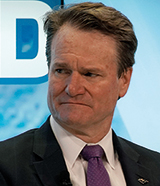Awards for Excellence 2018
|
The B of A-Team – Brian Moynihan’s plan comes together |
|
|
|
Also shortlisted |
Santander |
DBS |
| Citi |
| View full 2018 results |
Bank of America today looks like the template for modern-day banking. With one of the biggest technology investment budgets of any large bank – $10 billion a year, with $3 billion devoted to new digital and mobile initiatives – it has invested heavily in being simple and efficient.
Only five years ago its vast US consumer bank offered customers the choice of around 1,400 products ranging across checking accounts, credit cards, mortgages, consumer loans, car loans, unsecured loans, deposit accounts, savings and investments.
Today it offers just 65 core products; with those it serves 67 million US customers, or one household in two. Far from being put off, they seem delighted by this simplicity. They are giving it more business. Customer satisfaction scores have never been higher.
Some 81% would now rate Bank of America a 9 or a 10 on a 10-point scale, up from just 70% a few years ago. It is picking up market share of deposits and loans even in a competitive and crowded marketplace served by local and regional banks as well as national and international ones.
And this is just part of the story. The drive for operational excellence comes in the context of a wholesale re-orientation of the bank into one that concentrates on lower-risk customers than in the past. The belief articulated relentlessly by chairman and chief executive Brian Moynihan and his team since 2015 – the year Bank of America put the last big post-financial crisis settlement with the Department of Justice behind it – is that, now repaired, it must pursue only responsible growth.
That means broadening and deepening relationships with chosen clients, rather than seeking every dollar of revenue available from selling products to anyone that would respond to a mail shot. And this applies across the bank, not just its US consumer business but also its global markets businesses and its large corporate lending and investment banking division.
It has grown its markets balance sheet to support client activity, but daily value at risk is a mere fraction of the pre-crisis days. In aggregate, global markets did not suffer a one-day loss on any trading day last year.
Net charge offs are at historic lows. Last year’s Federal Reserve stress test found that Bank of America would suffer lower losses in a severe economic and financial market downturn than any of its large-bank peers. The latest test results in June confirmed this.
 |
| Brian Moynihan |
Efficiency enables this, of course. Over recent years the bank has retired more than 18,000 applications; streamlined from 488 mid-range server models to six standard models; consolidated 22 collateral management systems to one; reduced eight different teller systems to one unified system; consolidated 64 data centres worldwide to 14; and integrated 15 fraud and claims platforms to just one, while improving fraud detection at the same time.
It is also essential to drive down costs because margins on lower-risk business are by definition thin. The attractions of that have not always been obvious.
“We had some criticism over responsible growth at first from investors who suggested we were only talking about it because our competitors were growing faster than us,” Moynihan recalls.
But they have not been complaining recently. In the first three months of this year Bank of America enjoyed the most profitable quarter in its history, with net income of $6.9 billion, 30% ahead of the year before. The share price that had rattled along at between $16.50 and $17.50 from the end of 2013 to the end of 2016, started climbing last year, doubling in value from November 2016 to the end of the first quarter 2018.
“We don’t declare an ambition to be the biggest bank in the world, but if doing the right business with the right clients happens to take us there, then that’s fine by us.” – Brian Moynihan
Good risk management and a restrained risk appetite mean that Bank of America is set to serve customers and communities steadily across the cycle instead of over-extending credit in the good times and snatching it back in the bad and so contributing to pro-cyclicality. Moynihan points to Texas and the impact of the declining oil price as an example.
“We saw rapid growth in commercial real estate in Texas, for example, and some providers had to pull back,” he says. “By contrast, because we hadn’t grown too fast during the good times, we didn’t have to stop lending through the downturn in the oil price in early 2017. Rather we kept putting on new loans at pretty much the same rate.”
Investors now get it. Bank of America’s market capitalization rose from about $165 billion in November 2016 to over $330 billion in March of this year before settling down to just over $307 billion in mid June, as fears over trade wars and central bank tightening trimmed enthusiasm for large banks.
It is now the world’s third largest bank by market capitalization, behind only JPMorgan and Industrial and Commercial Bank of China. Bank of America ranked seventh in the world by this measure as recently as 2016.
“We don’t declare an ambition to be the biggest bank in the world either by market capitalization, by assets or by any other measure,” Moynihan tells Euromoney.
“Having that as your aim would be a good way to make mistakes. But if dealing with our customers – doing the right business with the right clients, taking appropriate risks – happens to take us to being the biggest bank in the world, then that’s fine by us.”


